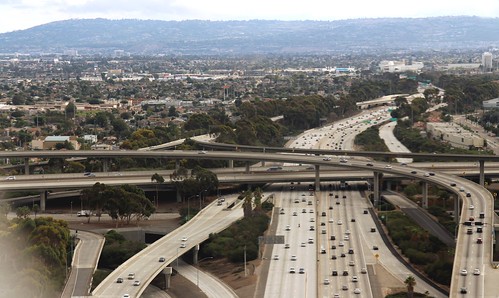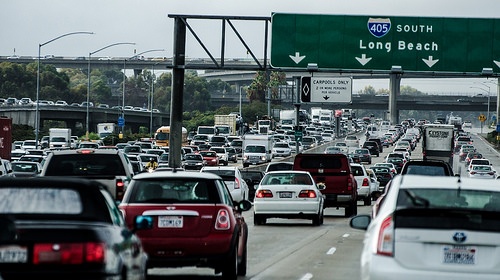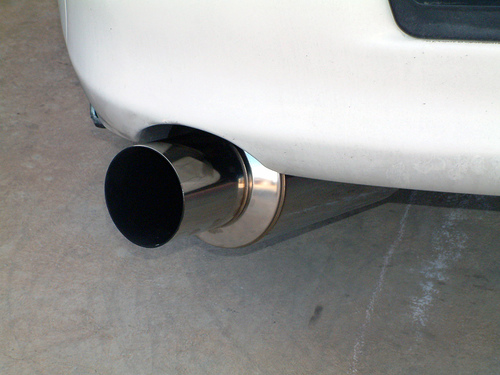The federal government has taken another step in its car wars with California. Late in September the Environmental Protection Agency (EPA) and the National Highway Traffic Safety Administration (NHTSA) issued joint rules declaring NHTSA’s preemptive authority to set national standards covering greenhouse gas (GHG) emissions from petroleum-fueled vehicles and electric vehicles, and revoking a waiver from EPA that lets California set such standards.
Read MoreAudit, Compliance and Risk Blog
Feds Issue Nationwide Motor Vehicle Greenhouse Gas Standards and Declare California’s Standards to be Preempted
Posted by Jon Elliott on Tue, Oct 22, 2019
Tags: California Legislation, Environmental risks, Environmental, EPA, ghg, Transportation, greenhouse
Remember when splashing through puddles, collecting pretty-coloured leaves and deciding to keep a caterpillar for a pet were part of getting to and from school? Imagine all that you would have missed if your walk to school as a kid had been replaced with a sterile car ride. October is International Walk to School month (iWalk) and that has got me thinking…
Could Walking Boost Creativity?
Friedrich Nietzsche once said, “all truly great thoughts are conceived while walking” and many of the world’s greatest thinkers have recognized the power of a walk to spark new ideas and thoughts. Charles Dickens felt that walking enabled him to develop novel ways to write and some say that his walking stick was almost as important for his writing as his pen. (Charles Dickens Museum) A Stanford study has confirmed this belief and found that walking does boost creative inspiration. According to the study, creative output increases by an average of 60 percent when a person is walking. (Stanford News) Apparently, even after a walk, creative juices continue to flow, which is great for kids just arriving at school.
Exercise for Life
Setting up good habits when a child is young can translate into an active teen and adult life. Being driven to school each day contributes to sedentary behaviors and since much of the day is spent sitting in a classroom, an opportunity to be active while walking to school can help to develop life-long patterns of choosing exercise. Canadian Physical Activity Guidelines recommend that kids aged 5 to 11 get at least 60 minutes of moderate- to vigorous-intensity exercise every day. (For details on these guidelines, see Canadian Physical Activity Guidelines.)
Clearing the Air
Car fumes are not healthy for anyone, but the one place that really should not have exhaust surrounding it is your local school. University of Toronto assistant professor, Matthew Adams, recently found that school kiss-and-ride drop-off zones are exposing children to increased levels of air pollution (see U of T News.) Knowing that your family has chosen to walk, and is not contributing to poor air quality around schools by driving a short distance and then idling, is empowering. The morning walk to school is a chance for students to breathe fresh air and means that kids arrive at school feeling more alert and able to learn.
Street Smarts
Many parents find that letting their kids walk to school helps kids to learn how to be responsible and to make decisions by themselves. Walking or biking to school is a great way to improve academic performance. A recent study found that children who exercise have more brain power. Researchers were able to show that physical activity can actually increase the size of children’s brains and that kids who are physically fit have a greater volume of grey matter in the frontal and temporal regions and the calcarine cortex, all of which are important for learning, motor skills and visual processing. (For more information, see Brain Power.)
Why Wouldn’t Kids Walk to School?
Some parents tell themselves that driving the kids to school is what is best for safety, but who is this really best for? When you consider that children are at a greater risk of injury in a car than while playing or walking, you really can’t put safety forward as the reason to drive them to school.
One fear that parents have is that their child will be kidnapped. Kidnappings are incredibly rare, but parents don’t want to be that 1 in 14 million, even though limiting their child’s independence is an expected outcome of not allowing them to experience the world on their own. A good way to quash this particular fear is to find a group of kids that can walk to school together. Set up rules on how everyone sticks together and no one is left behind. (For ideas on starting a walking school bus in your area, see Walking School Bus.)
Getting Involved
For those of you living in British Columbia, you can register a school to participate in the Walk and Wheel to School event (October 1 – 5th 2018) with the Directorate of Agencies for School Health (DASH BC). (See DASH BC for more information.)
Jane Dunne is a Senior Editor for Specialty Technical Publishers. She works on a diverse catalogue of environmental publications that are recognized across North America as effective tools to ensure regulatory compliance with complex requirements.
Read MoreTags: Health & Safety, Environmental risks, Environmental, Transportation
Feds Formally Propose to Roll Back Future Auto Emission Standards
Posted by Jon Elliott on Tue, Aug 21, 2018
 The Trump Administration has taken the next step toward rolling back automobile standards intended to reduce greenhouse gas (GHG) emissions. On August 2, the Environmental Protection Agency (EPA) and the National Highway Traffic Safety Administration (NHTSA) issued a joint proposal to replace emission standards previously adopted to tighten emission standards during model years 2021-2026, captioned the “Safer Affordable Fuel-Efficient (SAFE) Vehicles Rule for Model Years 2021-2026 Passenger Cars and Light Trucks.” The agencies present a formal proposal to extend existing emission standards through those years, but also seek comments on several variations on this proposal.
The Trump Administration has taken the next step toward rolling back automobile standards intended to reduce greenhouse gas (GHG) emissions. On August 2, the Environmental Protection Agency (EPA) and the National Highway Traffic Safety Administration (NHTSA) issued a joint proposal to replace emission standards previously adopted to tighten emission standards during model years 2021-2026, captioned the “Safer Affordable Fuel-Efficient (SAFE) Vehicles Rule for Model Years 2021-2026 Passenger Cars and Light Trucks.” The agencies present a formal proposal to extend existing emission standards through those years, but also seek comments on several variations on this proposal.
Tags: Environmental risks, Environmental, EHS, EPA, Greenhouse Gas, ghg, CAA, Transportation
What if I told you that safety wasn’t about you? That the ‘safety starts with you’ mantra no longer applies? What would you think? How would you act? Could this even be true?
Read MoreTags: Health & Safety, Training, Transportation
New Rules Tighten Greenhouse Gas Emission Standards for Heavy Duty Vehicles
Posted by Jon Elliott on Thu, Sep 15, 2016
The Clean Air Act (CAA) includes extensive regulatory requirements on “mobile sources,” which cover efficiency and emissions standards for a broad range of vehicles with internal combustion engines (automobiles, buses, aircraft), “nonroad engines and vehicles” (including lawnmowers, bulldozers and marine vessels), as well as motor fuel standards intended to promote cleaner burning fuels. The U.S. Environmental Protection Agency (EPA) uses CAA authority to set emission limits from engines, for CAA-regulated air pollutants, including carbon dioxide (CO2) regulated for its greenhouse gas (GHG) aspects.
Read MoreTags: California Legislation, Environmental risks, Environmental, EPA, Greenhouse Gas, ghg, climate change, CAA, Transportation
The U.S. Department of Transportation (DOT) defines national requirements for the transportation of hazardous materials, under what’s commonly called the Hazardous Materials Transportation Act (HMTA). DOT agencies promulgate most regulatory requirements with nationwide applicability, and delegate most administrative and oversight responsibilities to state transportation and highway patrol agencies. Delegated functions include state-level registration of motor carriers that transport hazardous materials by roadways, and licensing for their drivers.
Read MoreTags: Health & Safety, Environmental risks, Environmental, Hazcom, Transportation
DOT Converts Nearly 100 Variances Into Regulatory Options For Hazmat Shipping
Posted by Jon Elliott on Tue, Mar 29, 2016
Federal hazardous materials transportation laws assign the Department of Transportation’s (DOT’s) Pipeline and Hazardous Materials Safety Administration (PHMSA) general authority to designate hazardous materials and prescribe regulations for the “safe transportation of hazardous materials in intrastate, interstate, and foreign commerce.” PHMSA also prescribes criteria for handling hazardous materials, including training of personnel, inspections, and standards for operating and monitoring equipment.
These laws also authorize PHMSA and other DOT units to issue "special permits" that allow variances from federal requirements for up to two years. These special permits may be renewed for up to two years each time (and up to four years for variances from transport routing requirements). In 2012 “MAP-21” (Moving Ahead for Progress in the 21st Century Act) directed PHMSA to review special permits that had been in place for at least 10 years, and to adopt regulatory revisions by October 1, 2015. PHMSA was to apply the following factors to determine the suitability for adopting a special permit into its hazardous materials regulations (HMR):
Tags: Health & Safety, EHS, Hazcom, Transportation
Now in Effect: Electronic Logging Device Rules for U.S. Motor Carriers
Posted by STP Editorial Team on Tue, Feb 16, 2016
 Effective February 16, 2016, the U.S. Federal Motor Carrier Safety Administration (FMCSA) has revised the requirements for logging of commercial motor vehicle (CMV) drivers’ hours of service or “HOS.” A motor carrier operating CMVs must install and require each of its drivers to use an electronic logging device (ELD) to record the driver’s duty status no later than December 18, 2017.
Effective February 16, 2016, the U.S. Federal Motor Carrier Safety Administration (FMCSA) has revised the requirements for logging of commercial motor vehicle (CMV) drivers’ hours of service or “HOS.” A motor carrier operating CMVs must install and require each of its drivers to use an electronic logging device (ELD) to record the driver’s duty status no later than December 18, 2017.
Tags: Employer Best Practices, Health & Safety, Greenhouse Gas, ghg, Hazcom, Transportation
In recent years, VW officials have sometimes been quoted touting their “clean diesel” vehicles by paraphrasing one of their competitors—“this isn’t your grandfather’s diesel.” This month VW finally admitted to the U.S. Environmental Protection Agency (EPA) and customers worldwide that it “isn’t your regulator’s diesel” either. The company had programmed the electronics in millions of vehicles to provide false data during required emissions tests.
Tags: Health & Safety, Environmental risks, Environmental, EHS, EPA, Hazcom, CAA, Transportation
Safety Programs Are Essential For The Automotive Workplace
Posted by STP Editorial Team on Tue, Sep 29, 2015
“No one should have to sacrifice their life for their livelihood, because a nation built on the dignity of work must provide safe working conditions for its people.”
– Secretary of Labor, Thomas E. Perez
Tags: Employer Best Practices, Health & Safety, OSHA, Employee Rights, California Legislation, Environmental risks, Environmental, Transportation








